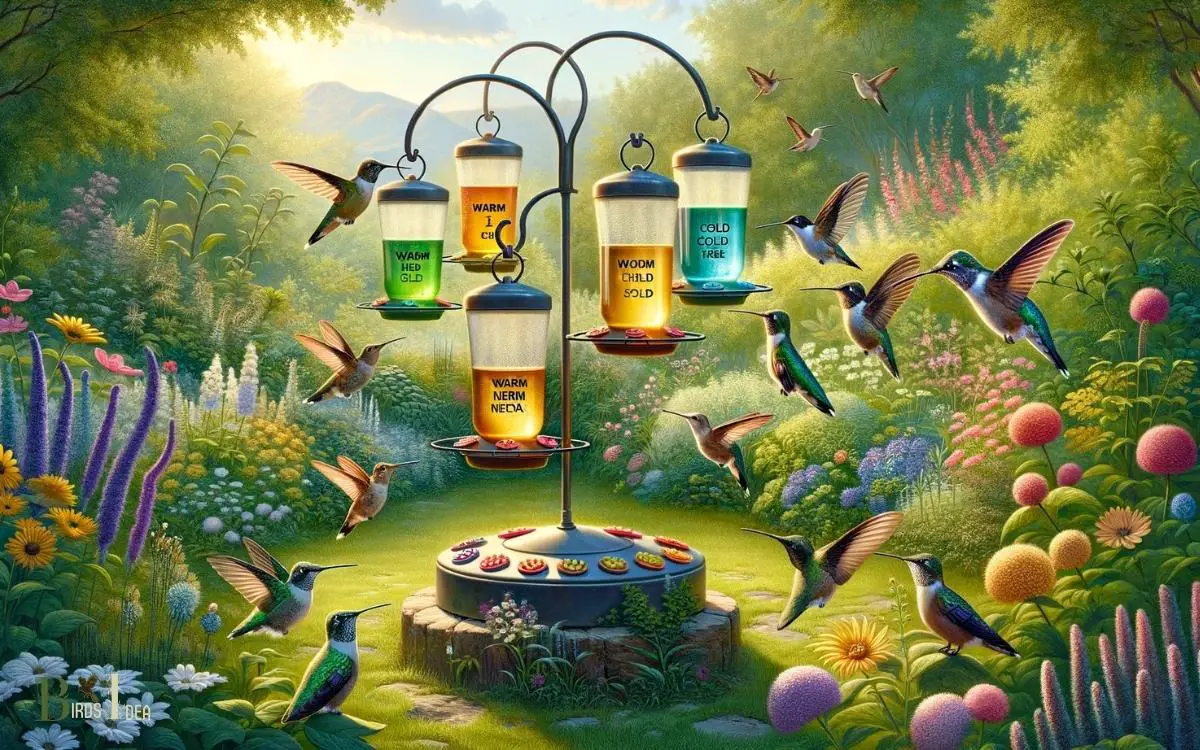Do Hummingbirds Like Warm or Cold Nectar? Warm Nectar!
Hummingbirds generally prefer warm nectar over cold. This preference is likely because warm nectar is closer to the temperature of the flowers they naturally feed from and can be more easily digested and utilized for energy.
Hummingbirds are attracted to nectar that is similar to the natural conditions they would encounter in the wild.
In nature, nectar found in flowers will often be warmed by the sun. Warm nectar can be more easily assimilated by a hummingbird’s metabolism, which is especially important given their high energy requirements.
Cold nectar can be a shock to their small bodies, particularly in cooler climates or during early mornings when temperatures are lower.
- Natural Preference: Mimics the warmth of sunlit flowers
- Metabolic Efficiency: Warm nectar is digested more efficiently
- Temperature Shock: Cold nectar can be harmful in cooler conditions
Optimize your hummingbird feeder by offering nectar at a temperature that mimics the warm, inviting allure of a sun-drenched blossom.

Key Takeaway
Hummingbird Nectar Temperature Preferences
Hummingbirds prefer nectar at a temperature between 70 and 80 degrees Fahrenheit for optimal consumption and digestion.
At lower temperatures, nectar becomes viscous and challenging for hummingbirds to extract from flowers, while excessively warm nectar can ferment more rapidly, posing potential health risks.
To ensure that nectar is within this preferred range, consider placing feeders in shaded areas to avoid direct sunlight warming the nectar excessively.
Using reflective materials around the feeder can help prevent solar heating. Monitoring the nectar’s temperature and making adjustments as needed can contribute to the well-being of these remarkable birds.
By understanding and accommodating their temperature preferences, individuals can play a significant role in supporting hummingbirds’ health and vitality.
Environmental Factors Affecting Nectar Temperature
Environmental factors play a crucial role in determining the temperature of hummingbird nectar.
The preference for warm nectar aligns with the hummingbird’s need for high energy levels, as cold nectar can slow down their metabolism.
The climate of the habitat directly impacts the temperature of the nectar, influencing the availability and accessibility of suitable food sources for hummingbirds.
Hummingbirds Prefer Warm Nectar
Studies have shown that nectar temperature significantly impacts the preference of hummingbirds.
Hummingbirds generally prefer warm nectar over cold nectar due to the physiological effects of temperature on their metabolism.
The table below summarizes the environmental factors affecting nectar temperature and their influence on hummingbird preference.
| Environmental Factor | Influence on Nectar Temperature |
|---|---|
| Ambient Temperature | Warmer ambient temperatures lead to warmer nectar |
| Sun Exposure | Nectar in sun-exposed locations is warmer |
| Time of Day | Nectar temperature increases during the day |
| Flower Color | Dark-colored flowers absorb more heat, warming the nectar |
| Geographic Location | Hummingbirds in warmer regions encounter warmer nectar |
Understanding these factors can help in providing suitable conditions for hummingbirds and ensuring that the nectar offered is at the preferred temperature, thereby supporting their well-being.
Cold Nectar Slows Metabolism
The preference of warm nectar by hummingbirds is influenced by various environmental factors affecting nectar temperature, with cold nectar having the potential to slow their metabolism.
When hummingbirds consume cold nectar, their metabolic rate decreases, which can impact their overall energy levels and ability to sustain their high activity levels.
This phenomenon is primarily due to the fact that cold temperatures slow down chemical reactions within the hummingbird’s body, affecting their ability to efficiently convert nectar into energy.
As a result, hummingbirds may experience decreased foraging and flight capabilities when consuming colder nectar.
Understanding the impact of nectar temperature on hummingbird metabolism is crucial for creating optimal feeding environments for these remarkable birds.
Transitioning into the subsequent section about ‘climate impacts nectar temperature’, it is essential to explore how various climatic conditions influence the temperature of nectar and its implications for hummingbird behavior.
Climate Impacts Nectar Temperature
Nectar temperature is influenced by various climatic conditions, impacting hummingbird behavior and foraging patterns.
Environmental factors such as air temperature, sunlight exposure, and humidity play crucial roles in determining the temperature of nectar available to hummingbirds.
In warmer climates, nectar tends to be warmer due to increased ambient temperatures, while in cooler climates, nectar temperature may be lower, affecting its attractiveness to hummingbirds.
Fluctuations in weather patterns and seasonal changes further contribute to variations in nectar temperature.
Understanding these environmental factors is essential for individuals who seek to provide the best conditions for hummingbirds, as it allows for the adjustment of nectar management practices to ensure optimal nectar temperature, ultimately supporting the well-being and foraging efficiency of these remarkable birds.
Influence of Seasonal Changes on Nectar Temperature
Seasonal changes have a significant impact on nectar temperature, which in turn affects the foraging behavior of hummingbirds.
As temperatures fluctuate throughout the year, the warmth or coolness of nectar can influence the energy expenditure and metabolic rate of hummingbirds.
Understanding the seasonal variations in nectar temperature is crucial for comprehending the ecological dynamics between hummingbirds and their food sources.
Nectar Temperature and Hummingbirds
As seasonal changes occur, the temperature of nectar plays a significant role in influencing hummingbird behavior and foraging patterns.
The influence of seasonal changes on nectar temperature can impact hummingbird activity in the following ways:
- Migration Patterns: Warmer nectar temperatures may lead to earlier migration as hummingbirds follow the blooming of flowers.
- Foraging Behavior: In cooler temperatures, hummingbirds may spend more time foraging to meet their energy demands, whereas in warmer temperatures, they may forage less frequently due to the higher energy content of warm nectar.
- Metabolic Rate: Hummingbirds’ metabolic rate may increase in cooler temperatures as they work to maintain body temperature, impacting their energy requirements and foraging habits.
- Reproduction: Warmer nectar temperatures may influence the timing and success of breeding, as it can affect the availability of nectar resources essential for successful reproduction.
Seasonal Impact on Nectar
The influence of seasonal changes on nectar temperature can significantly impact hummingbird behavior and foraging patterns.
As ambient temperatures fluctuate with the changing seasons, the temperature of nectar in flowers can vary accordingly.
During warmer seasons, nectar may naturally be warmer, while in colder seasons, nectar may be cooler.
This variation in nectar temperature can impact the energy expenditure of hummingbirds during foraging.
Warmer nectar may provide a quick source of energy, while cooler nectar may require more energy to warm up before digestion.
In colder seasons, hummingbirds may need to increase their foraging efforts to meet their energy requirements.
Understanding the seasonal impact on nectar temperature is crucial for conservation efforts and providing suitable resources for hummingbirds throughout the year.
Impact of Hummingbird Metabolism on Nectar Temperature
Hummingbird metabolism significantly influences the temperature of nectar consumed. This has a profound impact on their foraging behavior and overall energy balance.
Here are four key points to consider:
- Metabolic rate: Hummingbirds have extremely high metabolic rates, which enable them to maintain body temperatures significantly higher than the ambient temperature.
- Nectar temperature preference: Due to their high metabolic rate, hummingbirds prefer warmer nectar as it provides a quick source of energy and helps them maintain their high body temperature.
- Energy conservation: Consuming warmer nectar allows hummingbirds to conserve energy that would otherwise be spent on heating the nectar to body temperature.
- Foraging behavior: Hummingbirds may actively seek out warmer nectar sources, especially in cooler environments, to optimize their energy intake and expenditure.
Understanding the impact of hummingbird metabolism on nectar temperature is crucial for creating optimal feeding environments for these remarkable birds.
Temperature-Related Nectar Consumption Patterns
In relation to nectar consumption, temperature influences hummingbirds’ foraging behavior and metabolic efficiency. Warmer nectar temperatures, between 86-104°F (30-40°C), lead to increased foraging activity and higher metabolic rates in hummingbirds.
This is due to the fact that warmer nectar can be metabolized more quickly, providing the birds with a rapid energy source.
However, excessively high temperatures can be detrimental, causing nectar spoilage and reducing its nutritional value.
Cooler nectar temperatures, between 68-86°F (20-30°C), slow down metabolic rates in hummingbirds, potentially leading to reduced foraging activity.
Understanding these temperature-related nectar consumption patterns is crucial for providing suitable nectar solutions for hummingbirds in different environmental conditions, ensuring their optimal health and well-being.
Nectar Storage and Temperature Considerations
Nectar storage and temperature considerations directly impact hummingbirds’ foraging behavior and metabolic efficiency, with temperature playing a crucial role in the preservation and quality of nectar.
When considering nectar storage and temperature for hummingbirds, it’s important to keep in mind the following:
- Optimal Temperature: Hummingbird nectar should ideally be stored at a temperature of 70-80°F to maintain its quality and prevent fermentation.
- Avoid Direct Sunlight: Nectar should be stored in a shaded area to prevent overheating, which can lead to spoilage.
- Regular Replacement: Nectar should be replaced every 2-3 days in warm weather to prevent bacterial growth and maintain freshness.
- Use of Feeders with Thermal Regulation: Consider using feeders with thermal regulation features to keep nectar at the optimal temperature for hummingbird consumption.
These considerations are essential for ensuring that hummingbirds have access to high-quality nectar, promoting their health and well-being.
Is Homemade Warm Nectar Preferred by Hummingbirds?
Hummingbirds prefer homemade nectar due to its freshness and nutrient-rich content. The natural ingredients used in homemade nectar, such as pure cane sugar and filtered water, mimic the nectar found in flowers. Additionally, homemade nectar lacks harmful additives present in commercial mixes, making it a healthier option for these delicate birds.
Tips for Serving Ideal Nectar Temperature
When considering the optimum temperature for serving nectar to hummingbirds, it is crucial to maintain a range of 70-80°F to ensure its quality and prevent fermentation, which directly impacts the birds’ foraging behavior and metabolic efficiency.
To achieve this, it’s recommended to use a nectar feeder with UV-resistant materials, place it in shaded areas to avoid direct sunlight, and regularly monitor the temperature.
During warmer weather, refrigerating or adding ice packs to the feeder can help maintain the desired temperature.
Conversely, in cooler conditions, using insulated feeders or bringing the feeder indoors at night can prevent nectar from dropping below the ideal range.
By ensuring the nectar is served at the appropriate temperature, you can contribute to the well-being and thriving of the hummingbirds that visit your garden.
Conclusion
The temperature of nectar plays a significant role in the foraging and consumption patterns of hummingbirds.
By understanding the preferences and metabolic needs of these birds, we can better cater to their nectar temperature requirements.
For example, a study conducted in a controlled environment found that hummingbirds consumed nectar at a higher rate when it was maintained at their preferred temperature range, highlighting the importance of providing optimal nectar temperature for these avian species.






